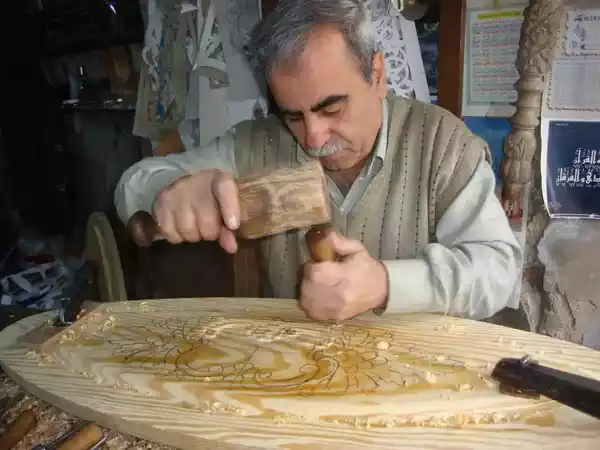From the ancient heritage of Syria. The art of engraving on wood.xylography
“Oyma” is a word that means engraving inscriptions and drawings on wood. It is a group of craftsmanship carried out by skilled hands to transform wood into beautiful arts that reveal life stories. Perhaps the wooden walls of the houses of ancient Damascene houses suggest the age of that industry and the extent of the care and artistry of Damascene carpenters in it.

The wood used in its manufacture is of various types, including (poplar, walnut, olive, sherbine, hawthorn, juniper, elm, sandalwood, pine and cypress), and from it decorative furniture, tables, seats, chairs, chests, and some musical instruments such as lute, tambourine, percussion, and in Aleppo and Damascus in the past two centuries, even houses and palaces were equipped with most of them from wood. As for the tools for its manufacture so far, it is very simple manual, limited to a hammer and chisel to dig wood, and glue to fix the pieces.
Ahmed Abdel Haq, a wood carving worker, told Syria website: “One piece takes two or three days with us. The bedrooms take an average of two months or more, depending on the technology used in them. As for the small pieces, we work with them in free time or on demand, and we are not satisfied with relying On the timber of the Levant only, but we import timber from other regions, such as “Qalqilya and Romania.”
The most important thing that the craftsmen of this profession face, which they consider a source of livelihood for them now, is the high prices of used wood and the decline in the percentage of purchase because tourists are the largest group of buyers of carved wood pieces, and their presence in Syria has decreased after the deteriorating security situation in the shadow of the Syrian war.
Abu Maher from the city of Aleppo, who is fond of wooden antiques and an expert in every detail in it says: “I prefer the surface-carved pieces in the Arabic manner, derived from the Fatimids and Mamluks, and the manuscript in the Arabic Islamic language, more than the deep Frankish sculpture that includes the French with the English.”
There is the so-called process of inlaying wood with mother-of-pearl, which gives it a silver color as if it is studded with silver, which makes the piece of it double the price, and most of it is for decoration and “Samad” and not for use. Damascus “wood sabot” is an authentic Levantine term.
In a report broadcast by the Syrian satellite channel, an old man appeared who had taken wood engraving as his profession, saying: “If age was repeated a second time, I would have chosen it because of my excessive love for it. His imagination is cut by pieces, a profession that is widespread in the traditional neighborhoods of Bab Touma and Bab Al Sharqi.”
The craft of engraving on wood is spread throughout the old city of Damascus, depicting different styles of inscriptions.
The craftsmen derived the shapes used for engraving from the architectural and artistic heritage of the different historical periods that passed through the city, such as the Ayyubid, Mamluk and Fatimid periods.
Although most engravings are used as parts of the wooden furniture of Damascene houses, many of these works are made as individual pieces of art.
A Syrian heritage will remain as long as the Syrian people mastered it in its smallest details and wanted to echo it beyond the borders of Syria, to remain an archaeological symbol witnessing the originality of the arts and professional manual skills that imitated its drawings by everyone who realized its greatness.



